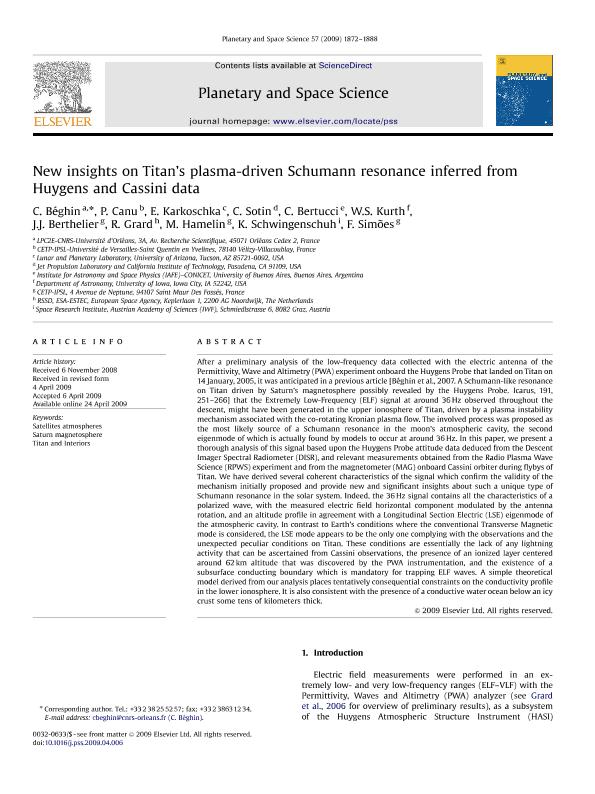Mostrar el registro sencillo del ítem
dc.contributor.author
Béghin, C.
dc.contributor.author
Canu, P.
dc.contributor.author
Karkoschka, E.
dc.contributor.author
Sotin, C.
dc.contributor.author
Bertucci, Cesar

dc.contributor.author
Kurth, W. S.
dc.contributor.author
Berthelier, J. J.
dc.contributor.author
Grard, R.
dc.contributor.author
Hamelin, M.
dc.contributor.author
Schwingenschuh, K.
dc.contributor.author
Simões, F.
dc.date.available
2017-07-17T15:49:03Z
dc.date.issued
2009-12
dc.identifier.citation
Béghin, C.; Canu, P.; Karkoschka, E.; Sotin, C.; Bertucci, Cesar; et al.; New insights on Titan's plasma-driven Schumann resonance inferred from Huygens and Cassini data; Pergamon-Elsevier Science Ltd; Planetary and Space Science; 57; 14-15; 12-2009; 1872-1888
dc.identifier.issn
0032-0633
dc.identifier.uri
http://hdl.handle.net/11336/20677
dc.description.abstract
After a preliminary analysis of the low-frequency data collected with the electric antenna of the Permittivity, Wave and Altimetry (PWA) experiment onboard the Huygens Probe that landed on Titan on 14 January, 2005, it was anticipated in a previous article [Béghin et al., 2007. A Schumann-like resonance on Titan driven by Saturn's magnetosphere possibly revealed by the Huygens Probe. Icarus, 191, 251–266] that the Extremely Low-Frequency (ELF) signal at around 36 Hz observed throughout the descent, might have been generated in the upper ionosphere of Titan, driven by a plasma instability mechanism associated with the co-rotating Kronian plasma flow. The involved process was proposed as the most likely source of a Schumann resonance in the moon's atmospheric cavity, the second eigenmode of which is actually found by models to occur at around 36 Hz. In this paper, we present a thorough analysis of this signal based upon the Huygens Probe attitude data deduced from the Descent Imager Spectral Radiometer (DISR), and relevant measurements obtained from the Radio Plasma Wave Science (RPWS) experiment and from the magnetometer (MAG) onboard Cassini orbiter during flybys of Titan. We have derived several coherent characteristics of the signal which confirm the validity of the mechanism initially proposed and provide new and significant insights about such a unique type of Schumann resonance in the solar system. Indeed, the 36 Hz signal contains all the characteristics of a polarized wave, with the measured electric field horizontal component modulated by the antenna rotation, and an altitude profile in agreement with a Longitudinal Section Electric (LSE) eigenmode of the atmospheric cavity. In contrast to Earth's conditions where the conventional Transverse Magnetic mode is considered, the LSE mode appears to be the only one complying with the observations and the unexpected peculiar conditions on Titan. These conditions are essentially the lack of any lightning activity that can be ascertained from Cassini observations, the presence of an ionized layer centered around 62 km altitude that was discovered by the PWA instrumentation, and the existence of a subsurface conducting boundary which is mandatory for trapping ELF waves. A simple theoretical model derived from our analysis places tentatively consequential constraints on the conductivity profile in the lower ionosphere. It is also consistent with the presence of a conductive water ocean below an icy crust some tens of kilometers thick.
dc.format
application/pdf
dc.language.iso
eng
dc.publisher
Pergamon-Elsevier Science Ltd

dc.rights
info:eu-repo/semantics/openAccess
dc.rights.uri
https://creativecommons.org/licenses/by-nc-nd/2.5/ar/
dc.subject
Satellites Atmospheres
dc.subject
Saturn Magnetosphere
dc.subject
Titan And Interiors
dc.subject.classification
Astronomía

dc.subject.classification
Ciencias Físicas

dc.subject.classification
CIENCIAS NATURALES Y EXACTAS

dc.title
New insights on Titan's plasma-driven Schumann resonance inferred from Huygens and Cassini data
dc.type
info:eu-repo/semantics/article
dc.type
info:ar-repo/semantics/artículo
dc.type
info:eu-repo/semantics/publishedVersion
dc.date.updated
2017-07-17T13:33:40Z
dc.journal.volume
57
dc.journal.number
14-15
dc.journal.pagination
1872-1888
dc.journal.pais
Reino Unido

dc.journal.ciudad
Londres
dc.description.fil
Fil: Béghin, C.. Universite d’Orleans; Francia
dc.description.fil
Fil: Canu, P.. Universite de Versailles-Saint Quentin en Yvelines; Francia
dc.description.fil
Fil: Karkoschka, E.. University of Arizona; Estados Unidos
dc.description.fil
Fil: Sotin, C.. California Institute Of Technology; Estados Unidos
dc.description.fil
Fil: Bertucci, Cesar. Consejo Nacional de Investigaciónes Científicas y Técnicas. Oficina de Coordinación Administrativa Ciudad Universitaria. Instituto de Astronomía y Física del Espacio. - Universidad de Buenos Aires. Facultad de Ciencias Exactas y Naturales. Instituto de Astronomía y Física del Espacio; Argentina
dc.description.fil
Fil: Kurth, W. S.. University of Iowa; Estados Unidos
dc.description.fil
Fil: Berthelier, J. J.. Institut Pierre Simon Laplace; Francia
dc.description.fil
Fil: Grard, R.. European Space Agency; Países Bajos
dc.description.fil
Fil: Hamelin, M.. Institut Pierre Simon Laplace; Francia
dc.description.fil
Fil: Schwingenschuh, K.. Austrian Academy of Sciences; Austria
dc.description.fil
Fil: Simões, F.. Institut Pierre Simon Laplace; Francia
dc.journal.title
Planetary and Space Science

dc.relation.alternativeid
info:eu-repo/semantics/altIdentifier/url/http://www.sciencedirect.com/science/article/pii/S0032063309001020
dc.relation.alternativeid
info:eu-repo/semantics/altIdentifier/doi/http://dx.doi.org/10.1016/j.pss.2009.04.006
Archivos asociados
